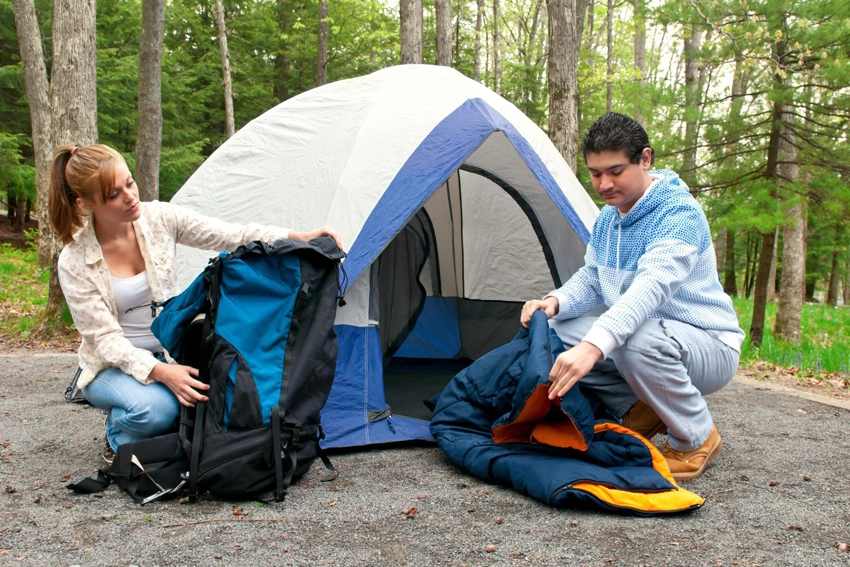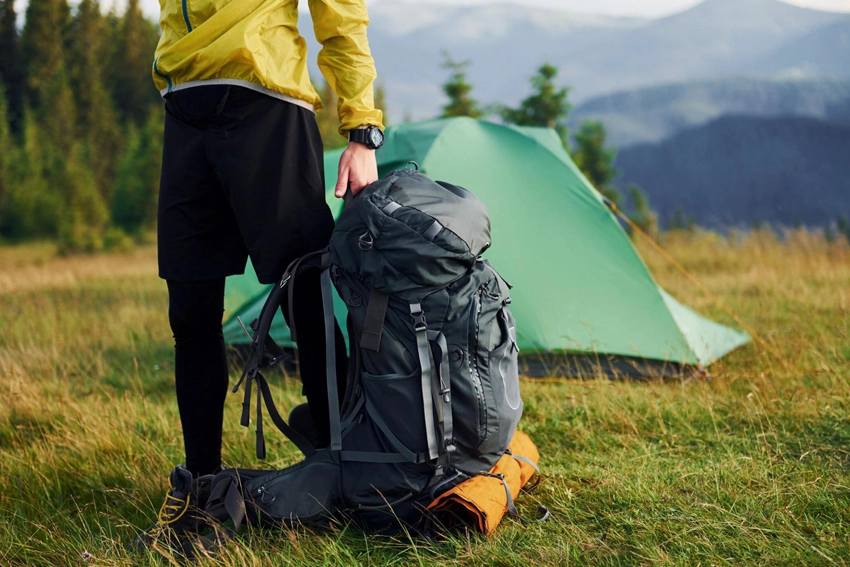Heading into the wilderness for a backpacking escapade demands meticulous planning and strategic packing, where every item stowed in your backpack assumes a pivotal role. Among these indispensable essentials, your tent stands out as a crucial refuge amidst the rugged landscapes.
Mastering the art of packing your tent is imperative for a triumphant outdoor expedition.
This manual will delve into the nuances of packing your tent for backpacking ventures, covering everything from choosing the appropriate tent to arranging its components within your pack. Each phase is pivotal for optimizing space, reducing weight, and ensuring convenient access to other essentials.
Come along as we explore the essential considerations and methodologies for packing your tent, equipping you to set forth on your wilderness escapade confidently and seamlessly.
Choosing the Ideal Tent

Efficiently preparing for your backpacking expeditions begins with the crucial task of selecting the perfect tent. Here are the key factors to consider:
Variety of Backpacking Tents:
Backpacking tents are available in diverse styles, each offering distinct features and considerations. Freestanding tents are self-supporting and easy to set up, while non-freestanding ones require stakes but are often lighter. Semi-freestanding tents offer a middle ground. Take into account variables such as weight, interior space, and weather resistance when deciding on the ideal tent for your needs.
Weight and Portability:
Backpacking tents vary in weight, ranging from ultralight options for minimalist hikers to more spacious ones with added features and durability. Evaluate how much weight you’re willing to carry and prioritize tents that balance weight with functionality. Seek out tents that can be compactly packed to save space in your backpack.
Capacity and Interior Space:
Assess the number of occupants who will be using the tent and select the capacity accordingly. Keep in mind that backpacking tents typically offer less room than those used for car camping, so choose one that provides ample space for sleepers to rest comfortably without feeling cramped. Consider additional features like vestibules for gear storage and interior pockets for organization.
Suitability for Seasons and Weather:
Choose a tent that matches the weather conditions you expect to encounter on your backpacking trips. Three-season tents are versatile and suitable for most conditions in spring, summer, and fall, while four-season tents are designed to withstand harsh winter conditions, including heavy snow and strong winds. Ensure that the tent’s rainfly and floor are constructed from durable, waterproof materials to keep you dry during adverse weather.
Ease of Setup and Durability:
Give preference to tents that are easy to set up and take down, especially if you’ll be pitching your tent in challenging terrain or unfavorable weather conditions. Look for features such as color-coded poles, intuitive pole clips, and quick-release buckles for straightforward assembly.
Moreover, focus on tents crafted from robust materials capable of enduring wear and tear from regular use on the trail. By carefully considering these factors and selecting a tent that aligns with your backpacking needs and preferences, you’ll ensure a comfortable and enjoyable outdoor adventure.
Take the opportunity to explore and test various tent models before making a decision, and invest in a high-quality tent that will withstand the rigors of your backpacking escapades.
Disassembling and Folding the Tent
Properly disassembling and packing your tent is essential for efficient storage and preserving its condition for future outings. Follow these step-by-step guidelines:
Remove Stakes and Guy Lines:
Start by extracting any stakes or guy lines securing the tent to the ground. Carefully pull out each stake, ensuring there’s no tension on the lines, and neatly coil the guy lines to prevent tangling.
Detach the Rainfly:
If your tent has a separate rainfly, detach it by unclipping or unzipping it from the main tent body. Lay the rainfly flat on the ground and fold or roll it neatly to minimize bulk.
Collapse the Tent Poles:
Next, collapse the tent poles following the manufacturer’s instructions. Most poles are connected by shock cords, making it easy to fold or collapse them into shorter segments.
Disassemble the Tent Body:
Once the poles are removed, detach the tent body by unclipping or unzipping it from the poles. Lay the tent body flat on the ground and smooth out any wrinkles or creases to facilitate folding.
Fold or Roll the Components:
Proceed to fold or roll each component of the tent, starting with the tent body. Fold it in half lengthwise, then into thirds or quarters, depending on its size. Repeat this process for the rainfly, folding or rolling it neatly to match the tent body’s size.
Organize and Secure:
After folding or rolling all components, arrange them logically to maximize space in your backpack. Place heavier items like tent poles at the bottom of your pack for even weight distribution. Use compression straps or stuff sacks to secure the tent components and prevent them from shifting during transit.
Perform Final Checks:
Before storing your tent, do a final inspection to ensure all components are properly folded, rolled, and secured. Double-check for any overlooked stakes or guy lines, and examine the tent body and rainfly for any damage or signs of wear that may need attention.
Packing Your Tent in Your Backpack
For efficient packing when preparing to stow your tent for your hike, adhere to these guidelines:
Starting with the Foundation:
Begin by placing the folded tent body or footprint at the base of your backpack. This establishes a solid foundation for your gear and encourages uniform weight distribution.
Organizing Tent Poles:
Vertically insert the collapsed tent poles along the sides of your backpack, utilizing any internal straps or pockets available. Ensure they’re positioned to minimize discomfort while in motion.
Incorporating the Rainfly and Additional Items:
Layer the folded or rolled rainfly atop the tent body, sliding it between the tent poles and the primary compartment of your backpack. If your backpack has external attachment points or pockets, consider securing the rainfly there to save internal space.
Keeping Small Items Together:
Store smaller tent accessories like stakes, guy lines, and repair kits in designated pockets or compartments within your backpack. Use zippered pockets, mesh pouches, or gear loops to maintain order and facilitate easy retrieval.
Compression and Adjustment:
Once everything is packed, employ internal compression straps or cinch straps to secure and compress the contents of your backpack. Adjust the straps for even weight distribution and balance during your hike.
Final Checks:
Before hitting the trail, conduct a final inspection to ensure everything is securely packed and balanced in your backpack. Verify that no stakes or guy lines are protruding, and take precautions to safeguard the rainfly from potential snags or damage.
Remember, proper packing guarantees a comfortable and hassle-free hiking experience.
Final Checks and Adjustments
Before embarking on your hike, it’s essential to conduct a thorough inspection to confirm your tent is securely packed and your backpack is properly adjusted. Here’s what to do:
Ensuring Stability and Equilibrium:
Test the stability and equilibrium of your backpack by shifting your weight from side to side. Verify that the weight is evenly distributed and your pack feels comfortable and steady on your back.
Inspecting Compression Straps:
Check that all compression straps are firmly fastened to compress the contents of your backpack and prevent shifting while you hike. Make any necessary alterations to maintain a balanced load and minimize movement.
Confirming Accessibility:
Ensure essential items like water bottles, snacks, and navigation tools are easily accessible without unpacking your entire backpack. Arrange items strategically to guarantee frequently used items are readily reachable.
Protecting the Rainfly:
Examine the rainfly to ensure it’s adequately shielded from potential snags or abrasions during your hike. Secure any loose ends or excess fabric under compression straps or using gear loops to prevent damage.
Ensuring Comfort and Fit:
Adjust the shoulder straps, hip belt, and sternum strap to attain a comfortable and secure fit. Confirm that your pack’s weight is evenly distributed and that the shoulder straps don’t cause discomfort.
Verifying Emergency Essentials:
Double-check that essential emergency items such as a first aid kit, navigation tools, and communication devices are easily accessible in case of emergencies. Familiarize yourself with their locations within your backpack for swift access during critical situations.
Considering Environmental Factors:
Evaluate environmental factors such as weather conditions, terrain difficulty, and potential hazards before commencing your hike. Adapt your gear and pack contents accordingly to ensure readiness for any challenges you may encounter.
Performing these final checks and adjustments will help guarantee a safe and enjoyable hiking experience.
In Conclusion
As you conclude your preparations for your backpacking expedition, you’ve refined the essential skills needed to pack your tent efficiently, ensuring a confident start to your journey. Through meticulous tent selection, strategic disassembly, and weight reduction, you’ve maximized space and guaranteed easy access to other essentials.
Before embarking on the trail, it’s vital to conduct final checks and adjustments to ensure your gear is securely packed, and your backpack is adjusted for optimal comfort and stability. Take the opportunity to familiarize yourself with your equipment and its contents, remaining adaptable to changes in environmental conditions and obstacles on the terrain.
For moments of relaxation and comfort at your campsite, delve into our guide to the finest backpacking chairs for a well-deserved respite after a day of exploration.
Above all, cherish the solitude and connection with nature that backpacking affords. Whether navigating challenging landscapes, setting up your tent under the stars, or exchanging stories around a campfire, each phase of your journey showcases your resilience, resourcefulness, and affection for the outdoors.
As you venture into the wilderness, may your backpacking adventures brim with unforgettable experiences, meaningful connections, and a profound reverence for the natural world. Safe travels, and may your journey be as enriching as the destination itself.





